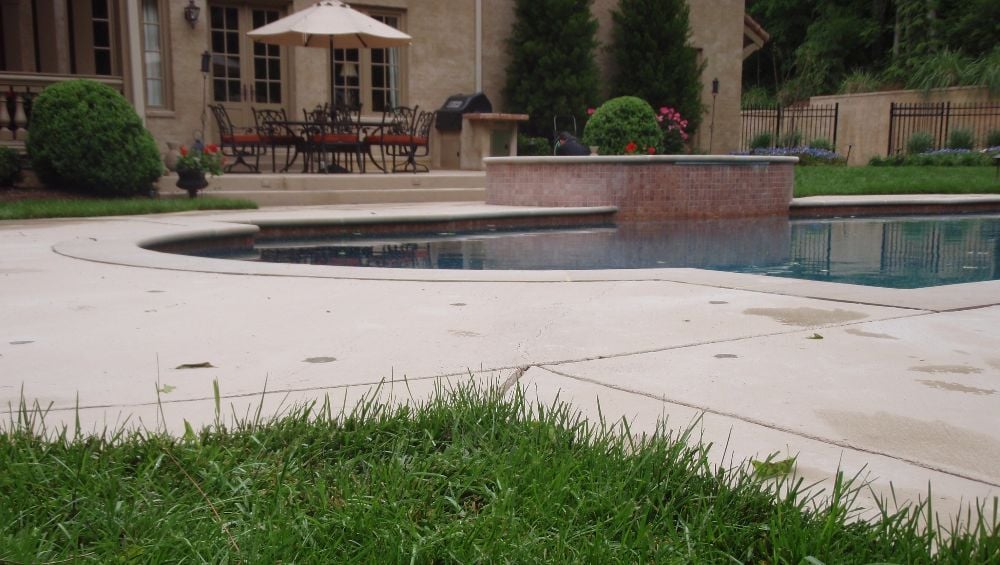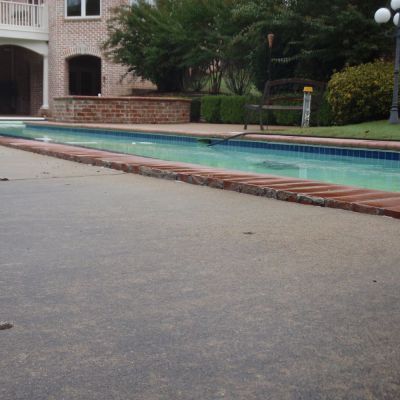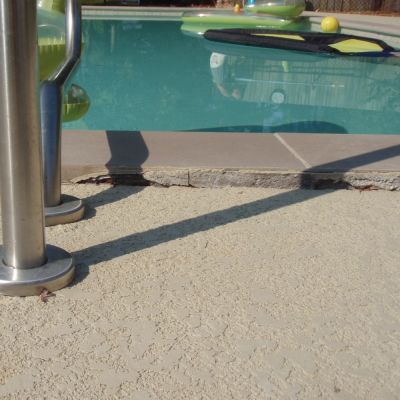
Find out how caulking your pool's concrete is a critical maintenance practice that can help protect and preserve your pool.
Swimming pools are a fantastic addition to any backyard as they provide a fun and relaxing way to cool off during the hot summer months with family and friends. However, owning a pool also comes with many responsibilities and a lot of maintenance.
One of the most important aspects of maintaining your pool is keeping the concrete surrounding the pool in good condition.
One of the key steps in doing this is caulking your concrete pool deck. Over the last three decades, we at A-1 Concrete Leveling have seen just how important it is to make sure any gaps, breaks, or cracks in pool decks are caulked and well taken care of.
In this article, we’ll discuss what exactly concrete caulking is, why you should do concrete caulking around your pool, how to caulk the concrete around your pool, and give you a look at what NOT to do when caulking your pool concrete.
What Is Concrete Caulking?
Concrete caulking is the process of applying a flexible caulk to the gaps and cracks in concrete slabs to prevent water from entering and eroding away at the substrate underneath, which can eventually cause settling.
Caulking can also help reduce trip hazards by filling large gaps or breaks, and can help prevent plants or weeds from sprouting up through the cracks in the concrete slabs.
Concrete caulking can be done almost anywhere where concrete has gaps or cracks, including driveways, sidewalks, porches, and pool decks.
Why Should You Caulk the Concrete Around Your Pool?
In addition to the general protective benefits of caulking mentioned above, caulking the concrete around your pool can be particularly beneficial for these reasons:
Prevent Foot Injuries and Trip Hazards
For starters, cracks, joints, and other gaps in the concrete can be very painful when stepped on with bare feet. Filling cracks and joints can help smooth them out and reduce the likelihood of injuries while walking, running, splashing, and playing around the pool.
Protect Your Pool Walls From Damage
Additionally, pool concrete caulking is a great solution to close up any breaks where water can flow underneath the slabs and along the pool walls, causing wash-out. Pool walls are expensive, so if you have a constant source of water hitting them from underneath, there could be a lot of damage to the pool walls over time.
Stop Your Pool Deck From Sliding
Also, if water has access to the underside of your concrete slabs through exposed gaps and cracks, the concrete pool deck can start to slide and settle as the sub-material washes away. If your pool required a lot of backfill or is situated on a hill, which is common, the pool deck can begin to slide over time, which can pull on all of the expensive pool components, like the walls, coping, and liner.
Pool decks settling and sliding are two of the main culprits behind pool liners tearing, which can lead to leaks, high water bills, and big liner replacement expenses.
Caulking the Gap Between Pool Coping and Concrete
The gap between the pool coping and a concrete pool deck is called an expansion joint, and it’s very important to keep it caulked in order to prevent water from flowing underneath the pool deck next to the coping.
The good news is, in most cases your coping sits on top of the pool wall, therefore, it’s less likely to move or settle. However, you still don’t want water to flow through the expansion joint and cause the adjoining pool deck slab to settle and break away from the coping.


When this happens, the coping sits higher than the pool deck and creates an unsightly trip hazard at the edge of the pool. Filling the expansion joint between the pool coping and concrete will allow water to flow over the gap instead of falling into it, preventing the pool deck from settling.
How to Caulk the Concrete Around Your Pool
Caulking concrete around a pool can be especially difficult because it is important to know how to adjust the caulk bead to the width of the expansion joint or crack. In addition, it is important, in most cases, to support the caulk correctly using a backer rod depending on which caulk is used.
Ensuring that you pick the right caulk to meet your aesthetic and functional requirements depends on where you live, what kind of pool you have, and other factors.
To help you get started, we have guides on concrete caulk types and how to caulk concrete gaps and cracks. The directions in our caulking guide are tailored to driveway caulking, but the steps are mostly the same for caulking gaps, cracks, and expansion joints around pools.
It’s important to remember the following if you plan on tackling pool concrete caulking yourself:
- Choose a non-sag or self-leveling caulk depending on the scope of your project
- Make sure all expansion joints are filled in with backer rod or sand before caulking
- Pick a caulk that matches well with the pool coping or concrete
- Have your concrete cleaned before a big caulking project so the caulk matches and adheres better
What NOT to Do: Pool Concrete Caulking
Don’t Use Mortar as Caulk
Filling the gaps and cracks around your pool deck with mortar or other rigid materials is a bad idea, and usually only a temporary solution. As the concrete expands and contracts with freeze-thaw cycles, the mortar breaks up and begins to crumble.
Not only does this look bad, but it can be dangerous, too. Sharp shrapnel-like pieces of broken mortar can cut feet as they’re walking around the pool deck.
A flexible material, like caulk made for concrete, will expand and contract with the concrete instead of breaking up or crumbling away.
Don’t Use Topical Sealers
While concrete sealer is different from concrete caulking, many people get both services done at the same time. You should not use topical sealers, which sit on top of the surface of your concrete, around pools as they get slippery when wet, they are hot when exposed to the sun, and they’re difficult to match with caulk.
Don’t Caulk Before Leveling
If you plan to both lift your settled concrete to a level position and caulk the gaps, cracks, and joints, you’ll have to do the concrete leveling first.
This is important because when the slabs are lifted, they move independently from one another. The caulk sealing off where one slab meets another will no longer be effective when the slabs move and shift position.
Your Next Steps
Concrete caulking is a key component of making sure your pool deck is maintained. Without concrete caulking, your pool deck could be riddled with dangerous trip hazards and settling slabs, leading to injuries and costly pool repairs.
Over the last thirty years, A-1 Concrete Leveling has specialized in repairing and preserving our customers’ concrete, including pool concrete caulking, sealing pool deck surfaces, and leveling uneven concrete around pools.
If you’re on the fence about pool concrete caulking, or you’re ready to discuss your options with an expert, click the link below to request a free onsite estimate with a member of the A-1 team!
Want to learn more? Click the links below to see related content from A-1’s Concrete Academy:
Sarah Etler joined A-1 Concrete Leveling after receiving her Bachelor of Arts degree in English from Northern Kentucky University. As A-1's Content Marketing Manager, she works closely with industry experts to produce content that will best answer questions related to concrete repair and maintenance practices. Sarah loves living a life full of discovery and is excited every day to see what new things she can learn and share with those around her.
Topics: